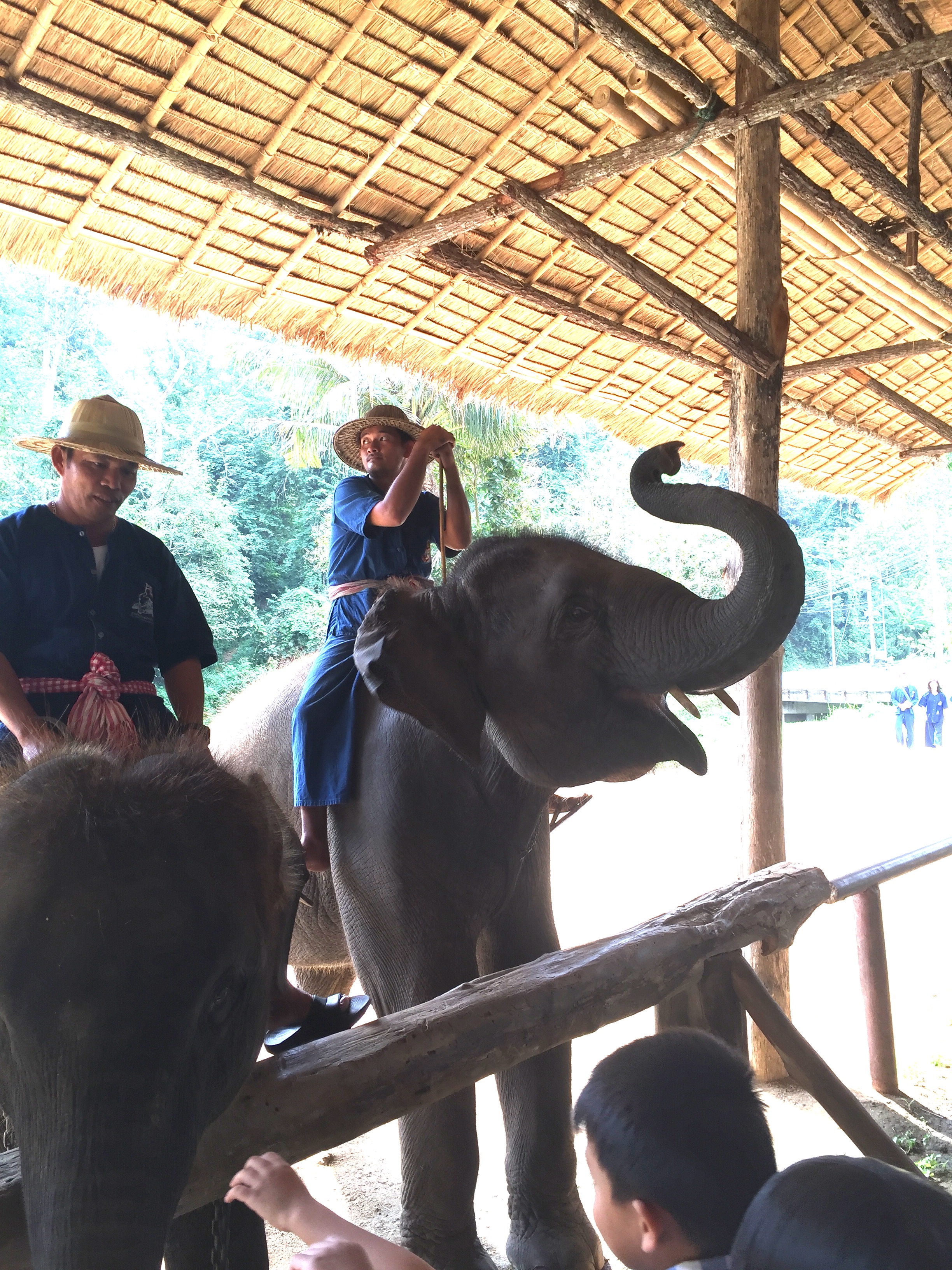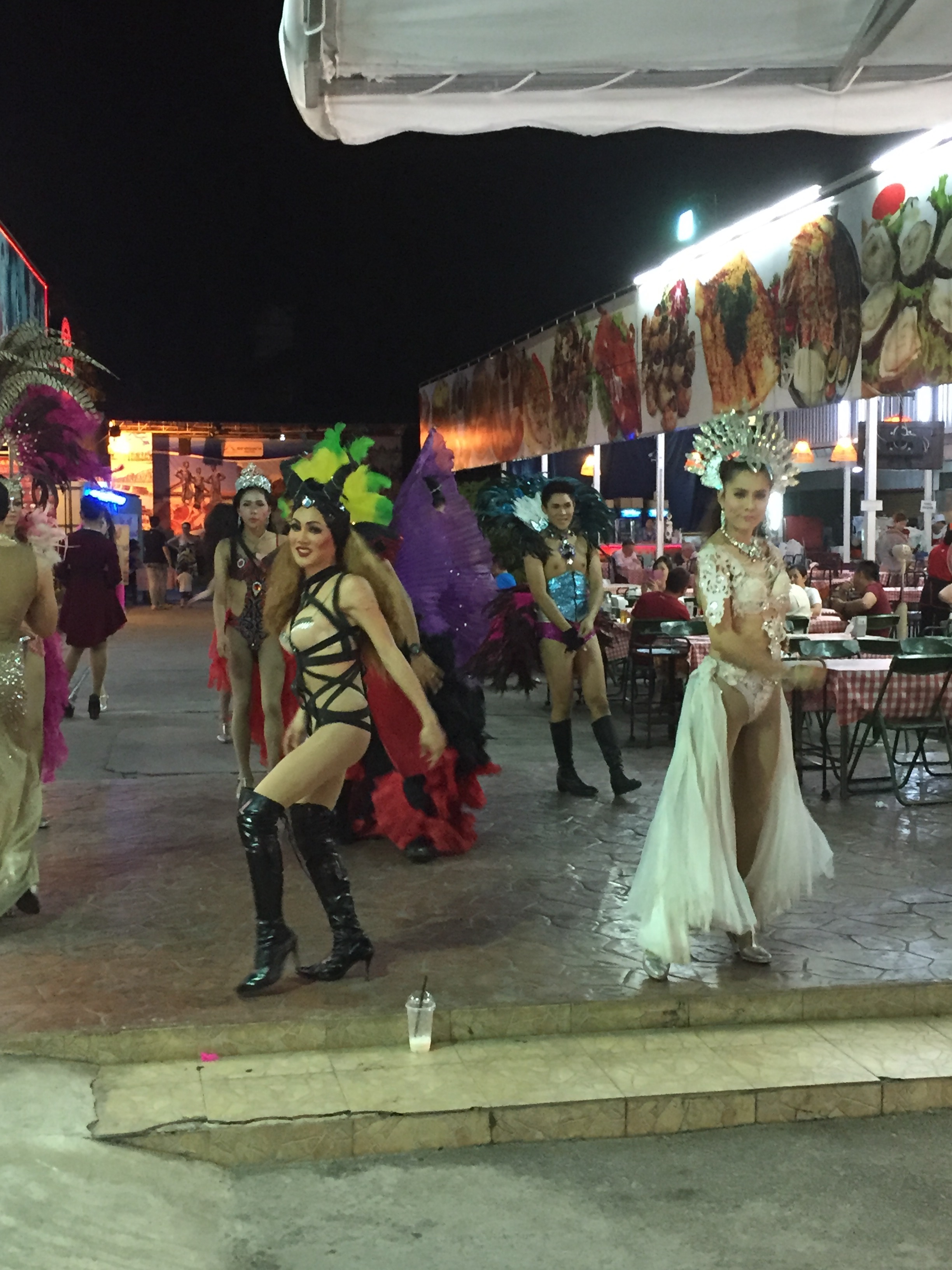by Betsy Herbert
December 26, 2015
Just three hours after my flight left the New Delhi airport at 10 a.m. October 26 bound for Bangkok, the magnitude 7.5 Hindu Kush earthquake struck South Asia. Though the earthquake’s epicenter was in Afghanistan, there were hundreds of casualties in Pakistan and the tremors in New Delhi sent thousands of panicked people into the streets. I didn't learn of the earthquake until just after I arrived in Bangkok.
I had a few days to kill in Bangkok before meeting up with my next tour group, Intrepid Travel’s “30-day Indochina Loop,” which included Thailand, and later Laos, Vietnam and Cambodia.
I quickly learned that the Thais really know how to put on a show. Glitz is everywhere. . . in the ornate temples, the golden Buddhas, the orchestrated elephant performances, and the brash "Ladyboy" shows.
Bangkok is huge, crowded, and criss-crossed with freeways. With 9 million cars, it's no surprise that Bangkok is smoggy. To add to the discomfort, it was in the 90s F and humid when our tour group assembled. To cool off, we took a canal tour of Bangkok on the ChaoPraya River, which used to be the city's main transportation artery before cars took over.
Our long, narrow river boat cruised through some beautiful neighborhoods with houses on stilts built right on the water. This is prime real estate in Bangkok, handed down from one generation to the next.
Cruising the canals of Bangkok through a fascinating neighborhood of houses built on the water.
Both the river and canals were choked with invasive water hyacinth, a non-native invasive species that steals habitat and nutrients from native plants. Leave it to the resourceful Thais, though. They harvest the water hyacinth, dry it and use it make shoes, handbags, baskets and furniture. I don’t know how effective this use is in controlling the spread of water hyacinth, though, which is an acknowledged environmental problem.
Bangkok's ChaoPraya River is choked with invasive water hyacinth.
Bangkok temples are everywhere, standing in striking contrast to the 21st century skyscrapers that abound in the city. Thai temples are ornate, curvilinear, colorful and and glitzy beyond belief. It seems that each successive king built fancier and fancier temples to try to leave his mark in history. Who knows how much time and money have been spent constructing temples over the centuries?
Perhaps as a political statement about all of this glitz, the Thai artist Chalermchai Kositpipat designed and constructed Wat Rong Khun, or the White Temple in Chang Rai in 1997 (see photo below).
The style of the White Temple is reminiscent of Salvador Dali meets the Grateful Dead. Its surreal exterior whiteness contrasts with the brilliant psychedelic murals inside, which are full of political and apocalyptic references. You are forbidden to photograph the interior of the White Temple, however, so I don't have photographs of the mind-blowing murals. But please check some of the images out at https://onarto.com/wat-rong-khun-doraemon/
The next day we took an overnight train ride to Chang Mai. . . and though it was billed as first class, it might be better described as an ordeal. Ever tried to use a squat toilet on a train? To make matters worse, somebody locked me out of my sleeper car in the middle of the night when I was in the WC. They latched the door from the other side, probably to stop it from banging all night long. I waited about 45 minutes before someone came along and opened it for me. Nearly had a panic attack!
The Boy on the Train. What helped make up for the discomfort of this monumental schlep was the efficiency and entertainment value of our young train steward. Just before lights out in the sleeper car, he methodically made up some 30 berths in the car. It took him only about 90 seconds to complete each berth by folding the chairs down into beds, putting on upper and lower sheets plus a pillowcase, and then attaching a curtain above each berth for privacy. It was a sheer wonder to watch him move, robot-like, never cracking a smile. All of the passengers were in awe as he proceeded down the car. When he finished we gave him a standing ovation. Not missing a beat, he beamed a big grin and took a dramatic bow. Well-deserved pride in a job well done!
Our amazing steward, otherwise known as "Boy on the Train," who provided entertainment and invaluable service on the otherwise uninspiring trip from Bangkok to Chang Mai.
Chang Mai. The next morning we arrived just after sunrise in Chang Mai. A few days before, my taxi driver at the Bangkok airport told me that Chang Mai is a haven for retired folks from Japan & Europe... apparently they can live like kings on their pensions. They’ve built lots of houses around Chang Mai, and they’ve infused a lot of dollars into the economy.
Chang Mai is also a big tourist draw. From what I could tell there are four main facets to tourism here: Temples, elephants, teak and sex tourism.
Temples. The famous temple Wat Phra Taht Doi Suthep is hugely popular. There, you can climb 306 steps up to the main complex. The view is lauded as spectacular, but the smog that day ruined it (I wonder if it is ever clear in Bangkok?).
Elephants. Like their larger African cousins, Asian elephants are a highly endangered species. According to the the American Museum of Natural History, hundreds of thousands of elephants roamed Asia until only about 100 years ago. Today, they have been wiped out from large areas of India, Southeast Asia and China, leaving fewer than 50,000.
I found three great places to visit Asian elephants in northern Thailand, all about an hour’s drive from the city of Chang Mai. Trouble is, the elephants in these places are not exactly wild. That’s because 95 percent of Thailand’s elephants are living in captivity, and nobody really knows how many wild elephants are left.
A friend and I drove to the Thai Elephant Conservation Center in the densely forested hills near Lampang. The TECC is a government-sponsored elephant camp that houses more than 50 Asian elephants (including six of the Thai Royal family’s white elephants). TECC seeks to educate tourists about the plight of elephants and to raise money for their conservation.
We watched the elephants bathe and frolic with their trainers in the creek flowing through the TECC grounds — truly a highlight of this trip!
After bathing, about a dozen elephants were led to a ring where they performed before an audience of some 200 tourists. They bowed as they were introduced one by one and did some cute tricks like removing the hats of their trainers. Later on, the elephants demonstrated how in the past, they were used to drag enormous logs out of the forest and stack them with their trunks. (Elephants are no longer used by the timber industry because the Thai government banned logging in “natural forests” throughout the country in 1989.)
Teak. At the beginning of the 20th century, the timber industry greatly increased logging of native teak and other tropical hardwoods in Thailand for export. Loggers began capturing and training large numbers of wild elephants to haul and stack logs. At the same time, this extensive logging destroyed much of the elephants’ natural forest habitat.
In 1988, Thailand experienced its worst flooding in 300 years, due to unsustainable logging and extensive forest clearing to create more agricultural land. So, in 1989 the Thai government banned logging in all natural forests in the country.
Elephants again. The logging ban put elephants as well as loggers out of work. Maybe not such a bad thing if the elephants could return to their natural habitats, but there was no place left for them to go.
In 1997, the Thai government founded the Thailand Elephant Conservation Center to help care for these “unemployed” elephants. The center advocates using elephants in tourism to provide income to care for them. Tourists can pay to ride the elephants after they pay to watch them perform.
Another organization, the Elephant Nature Park (ENP) is operated as a nonprofit to provide a natural sanctuary to treat and protect elephants from the sometimes harsh treatment in tourism as well as logging. They seek to re-introduce rescued elephants into the wild.
Third, the Thai Elephant Hospital, sponsored by Friends of the Asian Elephant, rescues and treats injured elephants. When we visited, we were introduced to Motala, a 50-year-old female elephant who was badly injured, like many others, by a land mine as she was working in the forest. The hospital manufactures prosthetic devices to fit these elephants like Motala to enable them to walk.
The Thai Elephant Hospital in Chang Mai makes prosthetic devices such as these for elephants injured by landmines in the forest.
Teak again. Well, I’ve already talked about the decimation of the native teak forests in Thailand, but you can still buy huge ornately carved furniture from large showrooms in Chang Mai, all guaranteed to be made from Thailand teak and rosewood; that is, from plantation forests.
Teak warehouse in Chang Mai where you can buy big, ornate furniture made from teak at discount rates. US tourists are the biggest consumers, according to warehouse personnel.
Though using elephants to haul and stack logs in forestry operations is now prohibited in Thailand, you can still buy a huge teak carving of a working elephant.
But on the showroom floor that I visited, a giant old-growth teak tree that had been recently felled was waiting to be carved up into lawn furniture in the US and Europe. When I inquired, the sales people told me that the timber was all sustainably harvested. Strange, but I didn’t believe them. How can cutting an old growth tree be sustainable? Oh, I almost forgot. We still allow cutting of old-growth redwood trees in California. Our state government claims that it’s sustainable too. H-m-m-m-m.
Me next to an old growth teak tree on the floor of the teak furniture manufacturer's warehouse in Chang Mai. This will be used to make lawn furniture. Yet, the warehouse claims to make furniture only out of "sustainably harvested" teak.
More sordidness: Sex tourism. Oh, let’s not forget another sordid side of Thai tourism. . .the sex trade. The tour group that I was part of didn’t address it, except that our guide forbade any of the tour participants to engage in prostitution. I don’t think anyone had that in mind on our tour, but I certainly observed lots of older Western gents around town with young, stiletto-heeled Asian women.
Lady Boy shows. Male transvestites, known as "Lady Boys," put on performances all over Thailand, and the shows are very popular. There was one show offered as part of our tour's evening entertainment. Another show was ongoing in Chang Mai's night market. You can read the bestselling book "Ladyboys: The Secret World of Thailand's Third Gender" (2008) by Sereemongkonpol and Aldous to learn more about this phenomenon.
Leaving Thailand. On November 2, our tour group left Thailand, bound for Laos. One of our last stops was in Chang Rai, to the White Temple that I described earlier. I'll end this blog with a shot of an outdoor sculpture at the White Temple:
Parting shot of Thailand...a sculpture outside of the White Temple in Chang Rai, seeking donations to the venue.
Stay tuned for my next blog about Laos.














